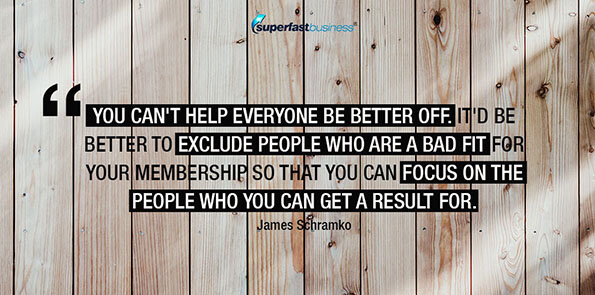When you have a group of people paying you a monthly fee, they start to feel entitled to the benefits that come with their membership. As well they should.
Membership owners James Schramko and John Lint deliver value on an ongoing basis to their paying audience. And in this episode of the membership series, they tell you how you can, too.
Podcast: Download (Duration: 23:12 — 21.4MB)
Get Notified Of Future Episodes Apple Podcasts | Spotify | Amazon Music | Android | Blubrry | Gaana | TuneIn | Deezer | Anghami | RSS | More
Episode topics:
03:20 – Why getting results is crucial. Your audience is interested in change, not more content.
09:06 – What segmentation does for a membership. Customer segmentation equals relevance, which equals happy customers.
13:36 – Adaptive ways to serve your members. If you can know your audience, you can deliver what they need, and personalize the experience.
16:04 – Being topic-specific with your training. Pay attention to your members, and translate it into your content.
19:01 – Are your SYSTEMs set up correctly? Discover how to Save Yourself Stress, Time, Energy, and Money.
Gain a reputation for results with James’s help
One of the great things about a membership site is it affords you a great deal of freedom as the owner. And you can enjoy this freedom while delivering stellar results for your members. James and KLEQ‘s John Lint are back to tell you how.
If you’re new to this podcast, you may want to check out the other episodes of our membership series. James and John have covered a range of topics: membership ideas, building a membership, getting traffic, how to price and sell. If you’re serious about running your own membership business, it’s worth starting from the beginning of the series.
Getting back to the topic at hand, however, why get results?
Why getting results is crucial
A paid membership is often a performance-based business – if people keep getting a result, they’ll keep paying you. Hence the need to stay at the top of your game. There must be a reason your audience will want to pay you every single month, says John.
“If you get in, but then you leave after a month, that sale didn’t matter.”
Say, like our co-hosts, you help people with their online businesses. Your aim then is not just to get them set up, but to help them bring in traffic, build an email list, maybe start campaigns. Every month you bring them closer to achieving the goal of a thriving business.
 As long as you are visibly doing your part to get results, your members are getting value, and they’ll continue to pay. And your job really, when it comes to delivering, is making sure that you first of all show up, says John. That’s one of the main things.
As long as you are visibly doing your part to get results, your members are getting value, and they’ll continue to pay. And your job really, when it comes to delivering, is making sure that you first of all show up, says John. That’s one of the main things.
Another is to avoid the mistake of making more and more content that is of no use to your members. It’s all about quality, not quantity. It’s about the effectiveness of your training. At the end of the day, you want your clients to feel that whatever they’re paying per month is a bargain compared to what they’re getting.
 It’s one thing to sell your membership. It’s another to have people stay. That’s where the money and the freedom is. Because you know then that you can work on your business whenever you want, and you have that peace of mind of knowing that every single month, you’re going to get X amount of money, because you’re taking care of your members, and they’re happy, and they are staying, and they are renewing every single month.
It’s one thing to sell your membership. It’s another to have people stay. That’s where the money and the freedom is. Because you know then that you can work on your business whenever you want, and you have that peace of mind of knowing that every single month, you’re going to get X amount of money, because you’re taking care of your members, and they’re happy, and they are staying, and they are renewing every single month.
The essential thing, says James, is you want to make sure no matter what your membership costs, whatever they pay, they feel like they’re getting more value than that, and they would miss it if they weren’t there.
“Personalize the experience.”
A number one tip is to personalize the experience. SuperFastBusiness is the only place on the planet where people can get James. He does a personal introduction, and he interacts personally with his customers. That in itself is great value. If you have fame and drawing power, you can use sub coaches, but that’s not the same and often doesn’t work.
What segmentation does for a membership
The other way to really hyper-personalize something is customer segmentation. Segmentation is basically saying, not all my customers are exactly the same. Not all my customers have the same problem that they’re trying to solve.
There are memberships with only one kind of customer, solving one kind of problem. In a membership like James’s however, people have multiple different problems, and they’re at different places in their business journey. So James sorts people out, and focuses on activities personalized for each person. Nothing is more personalized than a personal coaching discussion thread.
John explains how segmentation can work. Ideally, you can segment people upfront, whether it’s by asking a basic question or making them click on different things. You could do that in am email, where you ask a person to describe themselves and what they need. Are they starting out? Are they an advanced player? What are they looking to achieve?
You can send segmentation questions via email and apply tags based on where they click, in your emailing system. And if you’re using KLEQ.com, you can link that to create audiences. This gives you a way of having custom content on pages.
Basically, you want a way for people to identify themselves, so that you can customize their experience.
If someone entering the KLEQ.com Academy, for instance, identifies as a beginner, John has a series of emails directing them to the starter material. For advanced users, he can teach automation and advanced segmentation – stuff you don’t really need starting out, but powerful if you want to boost conversions.
Having an onboarding emailing sequence, having personal calls, having different groups for people – these are all ways of segmenting. In SuperFastBusiness, James has a chooser for people entering his sales campaign, with four different topics. And depending on the topic chosen, the segmented new members will receive a relevant welcome pack.
In Mercedes-Benz, says James, they would categorize prospects using the acronym SPACED – Safety, Performance, Appearance, Comfort, Economy, Durability. And they’d have a different conversation with the customer based on what they were most interested in.
Adaptive ways to serve your members
Another way to help get results is to be adaptive. James says he’s fairly platform agnostic and modality agnostic with his clients. Some of them like to write; others make Loom videos. Some post publicly in the forum; others do it privately. Some members update on a daily basis, while others do it less often. James adapts to their styles.
“Being innovative and adaptive to your clients will make a better experience for them.”
Being innovative and adaptive to your clients will create a better experience for them, rather than punching them all through a templated, one-way-fits-all-type system.
It’s all about personalization, says John, and people crave that these days. Just being able to answer someone’s question can be so valuable. That’s why every week he does a members-only Q&A call, lasting an hour or more, just so he can deliver that personal touch that makes his members happy.
Being topic-specific with your training
James’s next tip is to get some topic-specific training. He does that by being aware of conversations both private and public in his community. And he takes notes on coaching calls, and looks for patterns and trends.
If something comes up often, that will be the topic of his next training. So it’s always relevant. It pays to know your audience.
Like John, he has regular Ask Me Anything calls as well, where any of his members can turn up live and get answers. These are recorded and transcribed so anyone in the membership can benefit from the sessions.
In John’s Q&A calls, he also looks for trending questions. People interested in SEO? He creates the training. A lot can be achieved just by listening. He does much the same with KLEQ.com – if there’s enough demand for and value to be gained from a feature, he has it built into the software.
When you break it down to basics, says James, they’re just helping people be better off. And in order to do that, possibly the simplest possible system is KLEQ.com. They’ve talked before about not needing a lot of stuff. You just need to help someone get a result.
In this episode, they’ve added in the dimension of personalization and customization. It’s great, too, if you can stay fresh, bringing new ideas to the market instead of relying on five or ten years old information. That addresses the memberships where you pre-load 60 emails and sell for 10 bucks a month. You might get away with it now, but it’s unlikely.
Are your SYSTEMs set up correctly?
James’s next input is to set your SYSTEMs right. And by SYSTEMs, he means the things that Save You Stress, Time, Energy and Money. One of these is setting boundaries. Don’t try to serve everybody. You can’t help everyone be better off. It’d be better to exclude people who are a bad fit for your membership so that you can focus on the people who you can get a result for.
“People are not going to keep paying if they’re not using the product.”
In short, if you can’t get a result for somebody, don’t let them buy your program. A lot of sales people would say it’s on the buyer what they decide to purchase. But James thinks it’s important, if you have a membership and you want to keep getting paid, to realize people won’t keep paying if they’re not using it.
So James encourages people to use his membership. And he wants them to get results, amazing results. Because that’s bankable, and that increases the stock value of his membership in the market. So set some boundaries about who you serve.
He also recommends getting close to your clients. He does diagnostics with them, asks them for their challenges, interacts with them when they join. He does private coaching. He does all this to be relevant.
Realize, too, that whatever you start with now is not what you’re going to have in the future. So do your homework. See what else is out there, find out how other members are getting results with the things they’re buying. James remembers doing a survey once, that asked, What was the best membership you ever bought? What made it so good? He used those answers to inform the developments and changes he made for his own membership.
If you genuinely care about your clients, if you don’t let tech be an obstacle, if you are prepared to get involved, and set up a good routine, and keep your stuff fresh, and customize a bit for the people who need it, you’ll find they won’t leave. And that’s one of the most exciting things about a membership, because then you’re not stressed about getting more customers. You’re just looking after the ones you have.
Look for our next Membership Series episode, on retention strategies. James and John will let you in on more ways of keeping members around.
If you’re interested in an all-in-one membership solution, check out KLEQ.com. It integrates with most major email systems. It does all the billing. John’s team host it, secure it, and update it. All you do is pay a subscription, set up your content, tell PayPal or Stripe how much you want it to bill, and away you go.
Be among the thriving business owners inside James Schramko membership
Put the all-in-one membership features of KLEQ.com to the test
Liked the show? Leave us a review on iTunes











Leave a Reply